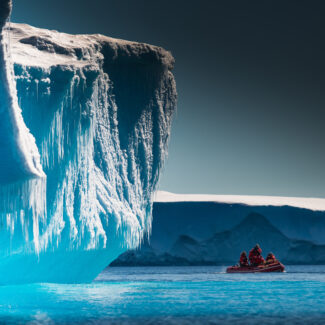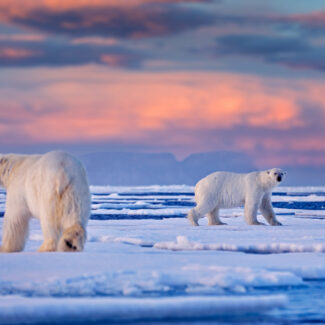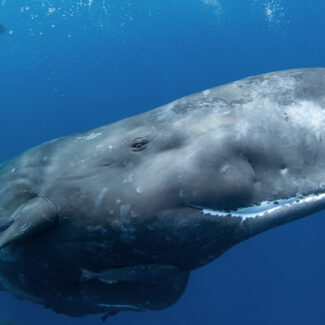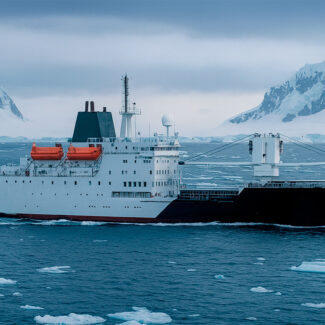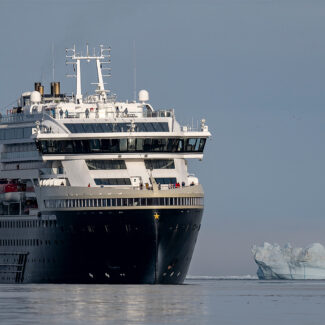9 Facts About The Greenland Shark: The Ancient Arctic Giant Of The Deep
- (1) Greenland Sharks Are (Along With a Close Relative) the Arctic’s Biggest Fish—and One of its Few Sharks
- (2) They’re Not Restricted to Arctic Waters, But Seem to Range Into Temperate & Lower Latitudes Only at Depth
- (3) They’re Exceptionally Slow-Growing—and Exceptionally Long-Lived
- (4) They’re One of Several Described Species of Sleeper Shark
- (5) They’re Among the Biggest of All Sharks
- (6) They’re (Apparently) Deceptively Fast
- (7) A Parasitic Copepod Often Hitches to the Greenland Shark’s Eyes
- (8) Their Flesh is Toxic
- (9) They have some Distinctive Dentition
- Where to See Greenland Sharks in the Arctic
Far less well-known than the polar bear or the orca, the Greenland shark is, nonetheless, an important top predator of Arctic waters just like them. It’s also a much more obscure member of the shark clan than such household names as the great white shark, and yet it reaches a comparable size and occupies a similar high-level trophic role in the marine food chain.
You certainly wouldn’t confuse a Greenland shark with a great white, which, to your average person, epitomizes the classic look of a shark: streamlined, tooth-grinning, with large and sharp-pointed fins. The Greenland shark looks more like a massive swimming cigar, with rather runty fins, a stubby snout, a smallish mouth, and a drab, brownish or grayish hide. That somewhat unassuming appearance belies its ability for explosive speed and impressive predation.
In this article, we’ll introduce you to this under-appreciated yet super-impressive beast, running through a series of Greenland shark facts that’ll elucidate much of what we know about the elusive species—and highlight how much remains to be discovered.
Explore the depths with us! This image captures the enigmatic Greenland shark, an ancient giant of the Arctic deep, revealing its mysterious presence in its icy domain.
Source: Hemming1952, CC BY-SA 4.0 <https://creativecommons.org/licenses/by-sa/4.0>, via Wikimedia Commons
(1) Greenland Sharks Are (Along With a Close Relative) the Arctic’s Biggest Fish—and One of its Few Sharks
Given their remote, hard-to-reach haunts and slow-growing nature (more on that shortly), it’s difficult to know exactly how large Greenland sharks can get—but we know for sure they get plenty big! Scientists estimate the species can reach in the vicinity of 24 feet long and weigh better than a ton. This makes them, along with their close relative the Pacific sleeper shark (thought to reach comparable, possibly even greater, lengths), the heftiest of all Arctic fishes.
Greenland and Pacific sleeper sharks are also some of the few of their kind to venture into such far northern waters. Other sharks known to penetrate at least the far southern outskirts of the Arctic include the porbeagle and salmon shark (two mackerel-shark relatives of the famous great white), the bluntnose sixgill shark (another deepwater giant), the basking shark (an enormous filter-feeder), and the spiny dogfish and Pacific spiny dogfish (small close cousins).
(2) They’re Not Restricted to Arctic Waters, But Seem to Range Into Temperate & Lower Latitudes Only at Depth
Greenland sharks can be found cruising surface waters in the Arctic—Greenland included—but we now know they actually range much farther south in the Atlantic Basin. But Greenland shark habitat changes with geography on account of their preferred temperature range: As a cold-adapted fish, though, their presence at lower latitudes is a deepwater one—some 4,000 or so feet (~1,200 meters) down or deeper. In 1988, a submersible ROV filmed an estimated 20-foot specimen 7,218 feet (2,200 meters) deep at the wreck of the SS Central America off the southeastern coast of the United States.
And in 2022, what was presumed to be either a Greenland shark or a Greenland/Pacific-sleeper hybrid was captured on a research longline in deep tropical waters off a Caribbean coral atoll in Belize.
(3) They’re Exceptionally Slow-Growing—and Exceptionally Long-Lived
Akin to some other polar and deepwater organisms, Greenland sharks show a notably sluggish growth rate: less than a centimeter per year, it’s been estimated. Females may not become reproductively mature until they’re more than a century old. What does that mean for the estimated Greenland shark lifespan? A large shark 20 feet or more long—and, as in most sharks, the females are the bigger sex—might well be several centuries old.
Indeed, evidence suggests that a Greenland shark’s lifespan can reach the better part of 400 years, with the radiocarbon dating of the eye lens nuclei of one particular 5-meter female giving her an estimated age of 392 ± 120 years old—the oldest Greenland shark on record. At almost half a millennium, this would make them the longest-lived known vertebrate, putting them in the sort of longevity territory we more associate, say, with trees rather than most animals.
(4) They’re One of Several Described Species of Sleeper Shark
Related to dogfishes, the sleeper sharks—genus Somniosus—include not only the Greenland and Pacific sleeper shark, but also the good-sized southern sleeper shark of higher-latitude Southern Hemisphere waters (including the sub-Antarctic) as well as the smaller Taiwan and little sleeper sharks and frog shark.
A 2017 Ecology & Evolution study investigated the evolutionary origins of the Greenland shark and its taxonomic relationship with the similar Pacific sleeper shark. It suggested that these two related species likely diverged on the order of a couple of million years ago, perhaps as a common and pan-oceanic deepwater ancestor experienced habitat fragmentation in the face of a cooling climate as the Pleistocene set in. With expanding sea ice and deepening ice shelves cutting off some of the ocean basins, marginal seas, and channels of the Arctic during that time, separated populations of this common ancestor may have given rise to the distinct Greenland and Pacific-sleeper lines. Interglacial periods of warmer conditions, meanwhile—such as we’re in now—have likely allowed some subsequent hybridization between those species, as “admixed” sleeper sharks have been documented today in parts of the Canadian Arctic.
(5) They’re Among the Biggest of All Sharks
Greenland sharks are among only a handful of shark species known to reach or exceed 20 feet in length. We’ve already noted that the Pacific sleeper shark likely attains a similar (or possibly even greater) size. The ultra-formidable great white shark—which doesn’t swim into the Arctic, though it does happily inhabit high-latitude cold-temperate waters such as the Gulf of Alaska—reaches between an estimated 20 and 23 feet long and can weigh more than two tons, being more massive than sleeper sharks. Common thresher sharks, great hammerheads, and tiger sharks are also thought to grow to the vicinity of 20 feet long.
Those are all “macropredatory” sharks, hunting good-sized prey. But the biggest of all sharks are filter-feeders such as the aforementioned basking shark, the maximum length of which may be between 30 and 40 feet. Even larger is the well-named whale shark, which may exceed 50 feet.
(6) They’re (Apparently) Deceptively Fast
The “sleeper-shark” tag refers to the sluggish appearance and often lethargic-looking swimming style these sharks display, as they saunter the depths at a distinctly dawdling average speed of 0.3 meters per second (0.67 mph). Yet Greenland sharks, like Pacific and southern sleeper sharks, appear quite capable of rapid bursts of speed: This is not an across-the-board slow shark.
The diverse diet of Greenland sharks, including a wide variety of fish from capelin, Arctic cod, Atlantic salmon, and Greenland halibut to Atlantic herring, wolffish, lumpfish, and sculpins, just goes to prove this. Some of these species are quite swift-swimming, as are other prey items such as squid.
Moreover, stomach-content analysis suggests Greenland sharks also target marine mammals such as ringed, hooded, and grey seals as well as Atlantic porpoises. While some of this mammal-eating probably goes down as scavenging, much evidence suggests the sharks are also active, opportunistic predators of these pinnipeds and cetaceans. Research out of the Norwegian archipelago of Svalbard suggests seals there might be most vulnerable to Greenland sharks when sleeping afloat—a tactic the sea-mammals may employ to reduce their risk to polar bears.
The stomachs of Greenland sharks have also yielded the blubber of beluga whales and narwhals, though these may well have been consumed in the form of carrion. Whether these smallish whales are occasionally actively hunted by Greenland sharks isn’t clear. Intriguingly, reindeer remains have also been found inside these sharks, and reputable accounts by biologists suggest Greenland sharks may opportunistically attack caribou swimming across seawater channels and straits, in sort of crocodile-style fashion.
(7) A Parasitic Copepod Often Hitches to the Greenland Shark’s Eyes
Greenland sharks are often caught or observed with a parasitic copepod, Ommatokoita elongata, attached to their eye. Although this copepod can do significant damage to the cornea, the shark’s likely reliance on smell over vision to locate prey suggests the parasite may not otherwise have a particularly deleterious effect on its host.
(8) Their Flesh is Toxic
Toxins in the flesh of Greenland sharks such as trimethylamine oxide (TMAO)—which are likely supporting the animal’s ability to withstand cold temperatures and extreme depths—make their fresh meat poisonous, and can cause symptoms similar to severe inebriation. Dried meat, however, is safer to eat, and has in many parts of the Arctic long been used as a food source for sled dogs and humans alike. Indeed, the much-enjoyed national dish of Iceland, Hákarl, involves curing Greenland (or other sleeper) shark meat with a particular fermentation process and hanging it to dry for four to five months, which safely removes the adverse effects of the neurotoxins.
(9) They have some Distinctive Dentition
Greenland shark teeth are highly unusual compared to those of any other shark—or indeed any other animal—both in their structure and in how the shark uses them to feed. While most sharks have serrated teeth in both upper and lower jaws designed for slicing, the Greenland shark features a unique combination of spiky, anchoring upper teeth and interlocking, sideways-angled, sawlike lower teeth for cutting, which gives rise to an unusual circular cutting motion which carves neat, round “plugs” of flesh from their prey.
Check out that bite! This illustration reveals the unique and serrated teeth of the Greenland shark – perfectly designed for their carnivorous diet in the deep Arctic waters.
Where to See Greenland Sharks in the Arctic
The well-documented range of the Greenland sharks extends from the Canadian High Arctic eastward to Russia’s Laptev Sea, and southward to the northeastern seaboard of North America as well as Iceland and the United Kingdom and Scandivania. As we’ve mentioned, the sharks are found farther south, but at increasingly greater depths that make mapping their complete distribution challenging.
Now, let’s be honest: Your chances of seeing a Greenland shark are virtually nil on an Arctic cruise. Your best luck would be seeing a harvested specimen where the species is commercially fished, or caught for traditional purposes. But you absolutely can thrill at the knowledge that, sailing through the stunning scenery of Greenland or Arctic Canada, these mysterious behemoths are cruising below, performing their essential role as a top-line predator in this precious and increasingly threatened polar ecosystem.
Disclaimer
Our travel guides are for informational purposes only. While we aim to provide accurate and up-to-date information, Antarctica Cruises makes no representations as to the accuracy or completeness of any information in our guides or found by following any link on this site.
Antarctica Cruises cannot and will not accept responsibility for any omissions or inaccuracies, or for any consequences arising therefrom, including any losses, injuries, or damages resulting from the display or use of this information.



